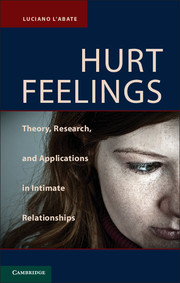Book contents
- Frontmatter
- Contents
- Preface
- Acknowledgments
- Introduction
- Part One Background
- Part Two The Scientific Bases of Hurt Feelings
- 6 The Discovery of Hurt Feelings
- 7 Biological Processes Underlying Hurt Feelings
- 8 Gender and Individual Differences in Hurt Feelings
- 9 Cultural Differences in Hurt Feelings
- 10 The Psychopathology of Hurt Feelings
- Part Three Applications of Hurt Feelings in Mental Health
- Part Four Models of Hurt Feelings In Theory and Applications
- Appendix A An Informed Consent Form to Deal with Hurt Feelings
- Appendix B Experimental Scale of Unexpressed Hurt Feelings
- References
- Author Index
- Subject Index
8 - Gender and Individual Differences in Hurt Feelings
from Part Two - The Scientific Bases of Hurt Feelings
Published online by Cambridge University Press: 05 June 2012
- Frontmatter
- Contents
- Preface
- Acknowledgments
- Introduction
- Part One Background
- Part Two The Scientific Bases of Hurt Feelings
- 6 The Discovery of Hurt Feelings
- 7 Biological Processes Underlying Hurt Feelings
- 8 Gender and Individual Differences in Hurt Feelings
- 9 Cultural Differences in Hurt Feelings
- 10 The Psychopathology of Hurt Feelings
- Part Three Applications of Hurt Feelings in Mental Health
- Part Four Models of Hurt Feelings In Theory and Applications
- Appendix A An Informed Consent Form to Deal with Hurt Feelings
- Appendix B Experimental Scale of Unexpressed Hurt Feelings
- References
- Author Index
- Subject Index
Summary
“In the last decade, thanks to unexpected butincredibly progressive advances in technology in psychology, psychiatry, and neurology, a great deal of information has been gathered around gender differences” (L’Abate, 2011c, p. 167).
This chapter will consider gender differences first and individual differences second in how genders deal with emotionality in general and with the presumed presence of hurt feelings in particular. The specific condition considered in this chapter within the context of emotionality is presumed hurt feelings because this construct might not be specifically addressed in the studies reviewed here (Brody & Hall, 2008; Burleson, 1997).
This chapter pays attention also to the wider cultural context of gender differences within the somewhat idealistic but relevant arguments made by Eisler (2009). She proposed going beyond the simplistic and overused dichotomy between capitalist versus socialist economies by presenting new dimensions between power-oriented and partnership-oriented economies. In the former, men dominate women at the expense of women and children, whereas in the latter, men and women are considered as coequals for the benefit of children, as in Scandinavian countries. The United States, for example, among others, represents a dominator-capitalist economy in which men hierarchically assume positions of power over subordinate women. China and Russia represent dominator-socialistic economies in which men are still at the top of the hierarchy at the expense of women and children.
- Type
- Chapter
- Information
- Hurt FeelingsTheory, Research, and Applications in Intimate Relationships, pp. 163 - 203Publisher: Cambridge University PressPrint publication year: 2011

